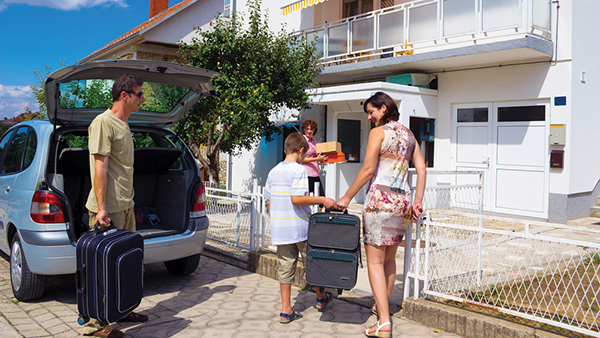If you’ve always wanted a vacation home but couldn’t afford one, you’ve probably considered obtaining that property via the Airbnb model: buying your vacation property and leasing it out as a short-term rental when you’re not using it in order to cover ownership costs. While this is a fantastic investment model that was successfully in use long before Airbnb became both a noun and a verb in the American vernacular, you must pay close attention to local regulations and choose your destination carefully if you hope to succeed.
Finding the Right Vacation Rental Home
AirDNA, a company that studies Airbnb data, says you need to pay attention to more than just home prices and projected daily rents if you want a successful AirBnB investing experience. You also need to know how the short-term rental business is doing in that particular area. Most importantly, you’ll need to study local short-term rental restrictions and stay up-to-date on what local city leaders might be planning. The company says all these factors “vary wildly from city to city and from street to street.”
AirDNA’s latest analysis of best and worst cities to buy Airbnb vacation home rentals indicates that Palm Springs, California, is among the most lucrative places to leverage Airbnb at this time. According to that report, there are 390 single-family home rentals in Palm Springs. The report only counted homes with two-to-four bedrooms, so larger homes, condos, and townhomes are not included in the estimate.
Palm Springs seems to be an ideal fit for an investor hoping to pay for a vacation home by renting it out. AirDNA’s data indicates Airbnb owners brought in an average $44,000 in profit for the year ending in May 2017. The average daily rate was $348.
Investors would have plenty of purchasing options in the area. Palm Springs is filled with unique homes that command higher daily rates along with more affordably-priced homes that would rent for much less. According to Zillow, the median home value in Palm Springs is $328,000, so you can certainly find relatively affordable homes in that city. As for the short-term occupancy rate, AirDNA says it was just 47.5 percent, indicating these homes could easily be used as vacation homes by the primary property owner.
In the number-two spot for short-term vacation rental returns is Sonoma, California. However, Sonoma had very different factors affecting the profit margin than Palm Springs. The average profit is about $34,000, and there are about 134 whole-house rentals with an average 53.9 percent occupancy rate and an average daily rate of $399. You can see some similarities between the two cities, but in Sonoma, the median price of a home is $655,000. Buying a vacation home there will cost you much more up front, and more each month if you are financing the home.
Don’t Let the Numbers Deceive You
Some markets have numbers that might be deceiving, especially if you are thinking that higher occupancy rates are automatically better for investors. For example, Mountain View, California, is at the bottom of the list in terms of Airbnb revenue. It has 103 short-term rental homes with an occupancy rate of 73.2 percent and an average daily rate of $234.
Looks good, right? After all, Airbnb owners are having no trouble getting their properties rented. However, when you add in your mortgage and other expenses, the average profit is actually a loss: -$25,000. The factor that has the biggest impact on the revenue is the cost of the home itself. Zillow states says median home price in Mountain View is almost $1.5 million. It’s likely that if people are short-term renting their homes, they are getting “help” with the mortgage, but not covering it fully.
As you can see, it’s vital to do your due diligence since the results can vary from neighborhood to neighborhood. The location in which you wish to vacation may not have the highest profit.
Impact of Short-Term Rental Regulations
Even if the numbers are perfect, you still may find yourself in a bad spot if you fail to examine city laws and even neighborhood regulations on Airbnb properties. Local ordinances may be the biggest wildcards for anyone considering investing in a short-term rental. These rules are constantly under debate and have become quite challenging for investors in some places. According to AirDNA, Berlin, Germany; Barcelona, Spain; and San Francisco and Santa Monica, California, are among the Airbnb hot-spots whose investors’ bottom lines have been hit hardest by local regulations.
It’s vitally important to review each locale’s rules for Airbnb properties separately. There is no consistency, and each city comes up with its own set of rules that change frequently. In San Francisco, the city placed a 90-day cap on the number of nights per year you can rent a whole house. In Santa Monica, California, the city banned rentals of 30 days or less. In Barcelona, which is teeming with tourists, there are big fines for illegal rentals. In Berlin, you can only short-term rent your place if you keep more than 50 percent of the home for yourself. In Ojai, California, short-term rentals were recently banned all together, including those already in operation.
Be Aware: Change is in the Air
Because regulations on Airbnb rentals can change so quickly, it can be hard to plan ahead unless you invest in an area with a history of investor-friendly regulations or none at all. Let’s go back to Palm Springs: Though it has been a profitable area so far, short-term rentals could be affected by complicated new rules enacted this year. They include a cap on the number of times per year properties can be rented. Furthermore, you can only have one vacation rental unless you were already operating multiple rentals before January 10th, 2017.
The city is also considering requiring training and testing for Airbnb operators. So be careful. The AirDNA results may look different for Palm Springs next year.
The cost of owning an Airbnb property is rising as well. Most cities already keep track of short-term rentals and require owners to pay a transient occupancy tax, like hotels. Some have even hired services that use technology to track rentals that are operating illegally, making it increasingly difficult to fly under the radar. The IRS is also cracking down, trying to get a piece of the profit as well.
The take-away here is to do the math ahead of time, and be familiar with any rules (or potential rules) that could keep you from meeting your revenue goals. You want a vacation home to relieve stress, not create it! Always run your calculations with a “worst-case” scenario. If the numbers still work, you’ll likely be in good shape.
Jewels in the AirBnB Crown
AirDNA identified Santa Fe, New Mexico, and Portland, Maine, as short-term “investment jewels” because they deliver between $28,500 and $30,500 in annual profits and have low upfront costs.
























0 Comments